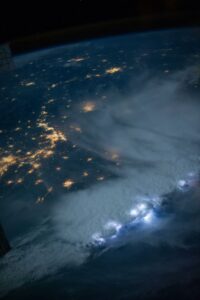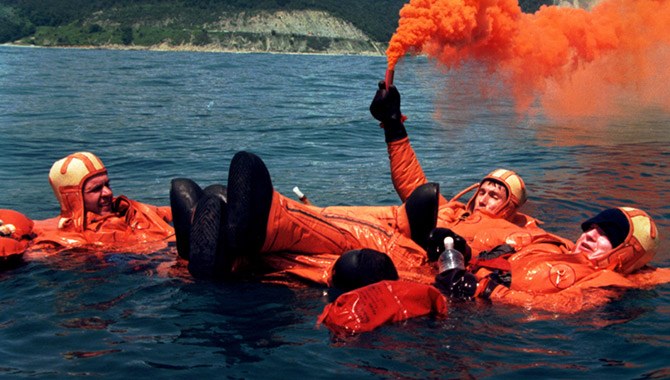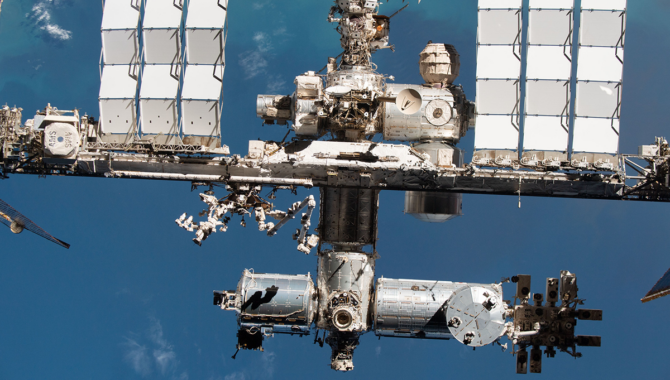
The International Space Station as seen from a SpaceX Crew Dragon capsule. In addition to the modules where astronauts live and work, several external structures are visible including the Alpha Magnetic Spectrometer seen on the far left. Photo Credit: NASA
In live Q&A session, the astronauts of ISS Expedition 70 discuss the challenges of weightlessness and the joy of watching lightning from space.
The International Space Station is an engineering marvel, the equivalent of a six-bedroom, two bath house orbiting about 260 miles above Earth at roughly 17,700 miles per hour. Assembled in space from components built on Earth, the state-of-the-art laboratory stretches 356 feet long, with a mass of more than 900,000 pounds. Eight miles of wire sends electrical power from the large solar arrays through the station to charge batteries and power the systems that support the astronauts and drive more than 20 cutting-edge scientific payloads at any time. It is the product of an effective international partnership agreement made by five space agencies and has hosted more than 270 astronauts.
“When you consider all that hardware, built around the world, coming together for the first time in space and working—that is a huge technical challenge that we have succeeded with,” said Robert D. Cabana, then director of NASA’s Kennedy Space Center, in a July 2015 oral history. “Even when there were problems, we were able to work around the technical challenges. That’s the advantage of having humans in space. They’re so adaptable. It’s great.”
Cabana, now NASA Associate Administrator, will retire from the agency on December 31, 2023, capping a 38-year career. He was the commander of space shuttle mission STS-88, which joined the first two segments of the ISS—the U.S. built Unity Node 1 and the Russian Zarya module—on December 6, 1998. After a series of EVAs to connect power between the two modules and install antennas, the crew entered the ISS for the first time on December 10, with Cabana and cosmonaut Sergei K. Krikalev moving through each door side by side.
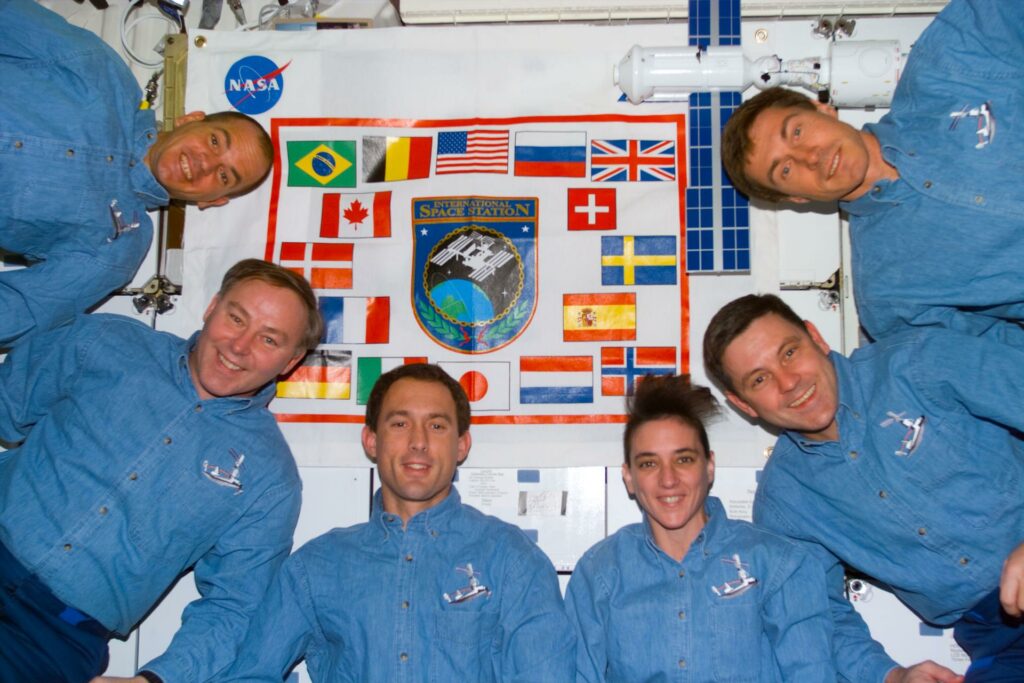
A pre-set electronic still camera (ESC) was used to take one of the traditional in-flight crew portraits for the STS-88 members on Endeavour’s mid deck. From the left are Frederick W. (Rick) Sturckow, Jerry L. Ross, James H. Newman, Nancy J. Currie, Robert D. Cabana and Sergei K. Krikalev. Krikalev, representing the Russian Space Agency (RSA), was assigned as one of the crew members for the first ISS crew. A banner representing the participating countries for ISS and a model (near Krikalev) of the connected Unity-Zarya modules are in the background. Photo Credit: NASA
That long day ended early the next morning. Mission Specialist James H. Newman, unable to sleep, made his way through the darkened middeck to the airlock and into the Unity module. Inside, he found Cabana and Krikalev were also awake, working inside the new space station. They stayed up until 4 a.m., discussing what the ISS would become, what it meant for international cooperation and scientific discovery, and how important it was to be working together to lay the cornerstone for this momentous project.
On December 6, 2023, Cabana joined ISS Program Manager Joel Montalbano to mark the anniversary of that eventful day by speaking with the crew members of Expedition 70, who are living and working aboard the ISS now.
“I cannot believe it was 25 years ago today that we grappled Zarya and joined it with the Unity node, Cabana said at the live question and answer event. “Absolutely amazing. And when you think of all that’s been accomplished on ISS in the last 25 years, 3,000 research and educational investigations from 108 countries around the world, we really appreciate what you guys are doing up there.”
Montalbano began the questions by asking the crew what aspects of life on the ISS surprised them after their extensive training on Earth.
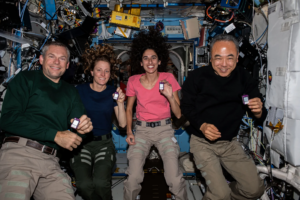
(From left) Expedition 70 Commander Andreas Mogensen of ESA (European Space Agency); and Flight Engineers Loral O’Hara and Jasmin Moghbeli, both from NASA; and Satoshi Furukawa of JAXA (Japan Aerospace Exploration Agency), pose for a portrait aboard the International Space Station’s Destiny laboratory module. The quartet is showing off crew active dosimeters that monitor the amount of radiation astronauts are exposed to in the microgravity environment.
Photo Credit: NASA
“Well, weightlessness. That is something that is truly unique up here,” said Andreas Mogensen, an astronaut with the European Space Agency and the Commander of Expedition 70. “There is unfortunately no way to train weightlessness on Earth. We can get a taste of it on a parabolic flight, but it’s just not the same as actually living and working in weightlessness up here. And it’s not just fun. It’s also very challenging whenever you have to find a piece of equipment or a tool in a bag and you have to get that piece of equipment or tool out without losing everything else in the bag. I mean, we’ve all, on multiple occasions, lost items. Luckily, most of them we found again near an air vent maybe a couple of minutes, maybe a couple of hours later.”
Next, Cabana asked the crew, which includes representatives from four of the five partner space agencies, what they have learned working together as an international crew.
Flight Engineer Jasmin Moghbeli, a NASA astronaut, noted that international collaboration is one of her favorite aspects of working on the ISS. “…We each bring our unique perspectives, not just from our different nationalities, but also our different [work] backgrounds… And so, I think you’re definitely strengthened by the international partnership. It’s just like gaining redundancy in things. When you have multiple partners working together, it’s stronger and more resilient to any sort of problems or obstacles that come in the way.”
Mogensen noted the impressive breadth of experiments on the ISS, from the Cold Atom Laboratory where the crew members are studying Bose-Einstein Condensates (particles very close to absolute zero), to the Alpha Magnetic Spectrometer mounted outside, which they are using to look for evidence of antimatter and dark matter. “Then we have the bio fabrication facility inside, which essentially is a 3D printer where we can print human tissue, human organs even, or at least that’s what we’re leading up towards. So, really the research up here spans so many fields and I think that’s incredibly interesting,” he said.
Later, Cabana asked, “One of the things that I loved to do whenever I had any spare time was just look out the window at the Earth as it went by. And I always told first-time flyers, ‘Stick your nose up to the window and make a memory.’ It’s really a special opportunity that you have. Is there anything that you’ve noticed looking down on the Earth that has caused you to think differently?”
“I was really amazed by the view of lightnings, those big fields of clouds and without any stop, like instantaneous lights here and there, sometimes they might be like five or 10 per second, and you see those fields of lightnings at night over the clouds, and that amazes me so much,” said Cosmonaut Konstantin Borisov, a Flight Engineer on Expedition 70.
“I think it’s a beautiful view of the Earth from the International Space Station, so that we recognize that we need to nurture the mother planet Earth,” said JAXA Astronaut Satoshi Furukawa, a Flight Engineer on Expedition 70.
“Well just thank you so much for your time,” Cabana concluded. “Treasure your experience up there together. It really is a special place. Thank you for all that you do. We look forward to seeing you all home back here on Earth. This is still a very special place, also.”
The International Space Station is a partnership between the space agencies of the United States, Canada, Japan, Russia, and the European Space Agency, whose current membership includes Austria, Belgium, Czech Republic, Denmark, Estonia, Finland, France, Germany, Greece, Hungary, Ireland, Italy, Luxembourg, The Netherlands, Norway, Poland, Portugal, Romania, Spain, Sweden, Switzerland, and the United Kingdom. To learn more about the ISS, click here.






